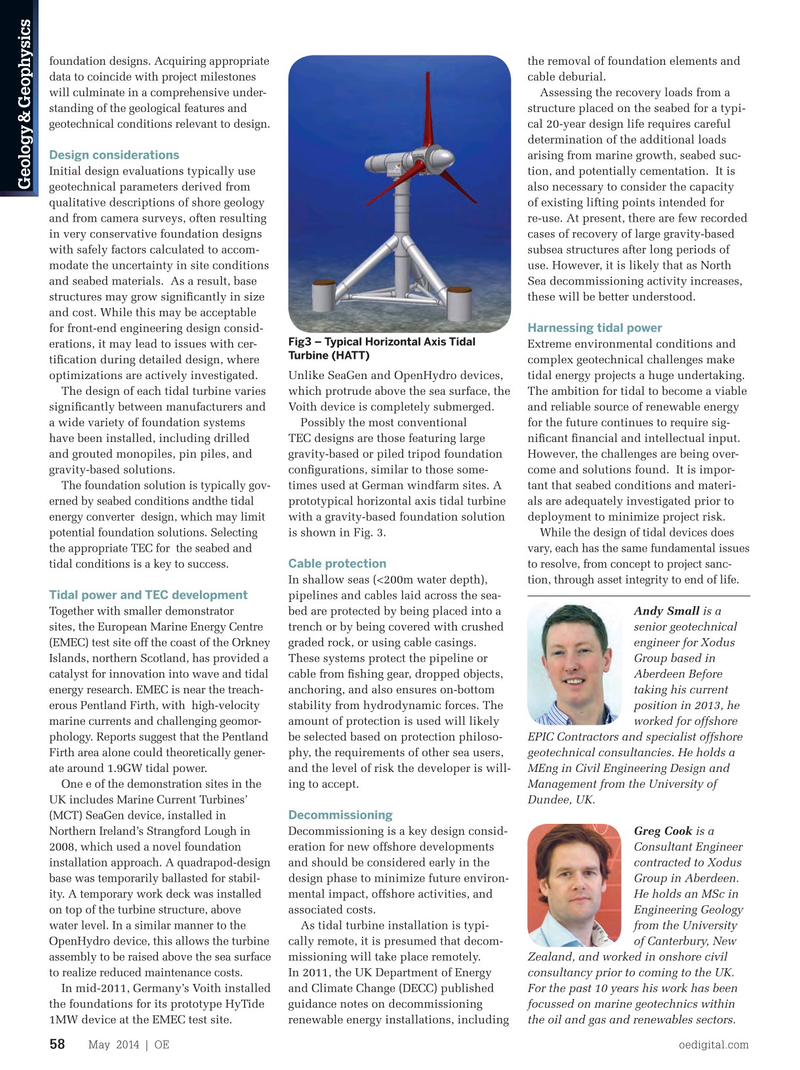
Page 56: of Offshore Engineer Magazine (May/Jun 2014)
Read this page in Pdf, Flash or Html5 edition of May/Jun 2014 Offshore Engineer Magazine
foundation designs. Acquiring appropriate the removal of foundation elements and data to coincide with project milestones cable deburial.
Assessing the recovery loads from a will culminate in a comprehensive under- structure placed on the seabed for a typi- standing of the geological features and cal 20-year design life requires careful geotechnical conditions relevant to design.
determination of the additional loads
Design considerations arising from marine growth, seabed suc-
Initial design evaluations typically use tion, and potentially cementation. It is
Geology & Geophysics geotechnical parameters derived from also necessary to consider the capacity qualitative descriptions of shore geology of existing lifting points intended for and from camera surveys, often resulting re-use. At present, there are few recorded in very conservative foundation designs cases of recovery of large gravity-based with safely factors calculated to accom- subsea structures after long periods of modate the uncertainty in site conditions use. However, it is likely that as North and seabed materials. As a result, base Sea decommissioning activity increases, structures may grow signifcantly in size these will be better understood.
and cost. While this may be acceptable
Harnessing tidal power for front-end engineering design consid-
Fig3 – Typical Horizontal Axis Tidal erations, it may lead to issues with cer- Extreme environmental conditions and
Turbine (HATT) tifcation during detailed design, where complex geotechnical challenges make optimizations are actively investigated. Unlike SeaGen and OpenHydro devices, tidal energy projects a huge undertaking.
The design of each tidal turbine varies which protrude above the sea surface, the The ambition for tidal to become a viable signifcantly between manufacturers and Voith device is completely submerged. and reliable source of renewable energy a wide variety of foundation systems Possibly the most conventional for the future continues to require sig- have been installed, including drilled TEC designs are those featuring large nifcant fnancial and intellectual input. and grouted monopiles, pin piles, and gravity-based or piled tripod foundation However, the challenges are being over- gravity-based solutions. confgurations, similar to those some- come and solutions found. It is impor-
The foundation solution is typically gov- times used at German windfarm sites. A tant that seabed conditions and materi- erned by seabed conditions andthe tidal prototypical horizontal axis tidal turbine als are adequately investigated prior to energy converter design, which may limit with a gravity-based foundation solution deployment to minimize project risk. potential foundation solutions. Selecting While the design of tidal devices does is shown in Fig. 3.
the appropriate TEC for the seabed and vary, each has the same fundamental issues
Cable protection tidal conditions is a key to success. to resolve, from concept to project sanc-
In shallow seas (<200m water depth), tion, through asset integrity to end of life.
Tidal power and TEC development pipelines and cables laid across the sea-
Together with smaller demonstrator bed are protected by being placed into a Andy Small is a sites, the European Marine Energy Centre trench or by being covered with crushed senior geotechnical (EMEC) test site off the coast of the Orkney graded rock, or using cable casings. engineer for Xodus
Islands, northern Scotland, has provided a
These systems protect the pipeline or Group based in catalyst for innovation into wave and tidal cable from fshing gear, dropped objects, Aberdeen Before energy research. EMEC is near the treach- anchoring, and also ensures on-bottom taking his current erous Pentland Firth, with high-velocity stability from hydrodynamic forces. The position in 2013, he marine currents and challenging geomor- amount of protection is used will likely worked for offshore phology. Reports suggest that the Pentland be selected based on protection philoso- EPIC Contractors and specialist offshore
Firth area alone could theoretically gener- phy, the requirements of other sea users, geotechnical consultancies. He holds a ate around 1.9GW tidal power.
and the level of risk the developer is will- MEng in Civil Engineering Design and
One e of the demonstration sites in the ing to accept. Management from the University of
UK includes Marine Current Turbines’
Dundee, UK.
Decommissioning (MCT) SeaGen device, installed in
Decommissioning is a key design consid- Greg Cook is a
Northern Ireland’s Strangford Lough in eration for new offshore developments Consultant Engineer 2008, which used a novel foundation and should be considered early in the contracted to Xodus installation approach. A quadrapod-design design phase to minimize future environ- Group in Aberdeen. base was temporarily ballasted for stabil- mental impact, offshore activities, and He holds an MSc in ity. A temporary work deck was installed associated costs. Engineering Geology on top of the turbine structure, above water level. In a similar manner to the
As tidal turbine installation is typi- from the University
OpenHydro device, this allows the turbine cally remote, it is presumed that decom- of Canterbury, New assembly to be raised above the sea surface missioning will take place remotely. Zealand, and worked in onshore civil to realize reduced maintenance costs.
In 2011, the UK Department of Energy consultancy prior to coming to the UK.
In mid-2011, Germany’s Voith installed and Climate Change (DECC) published For the past 10 years his work has been the foundations for its prototype HyTide guidance notes on decommissioning focussed on marine geotechnics within 1MW device at the EMEC test site. renewable energy installations, including the oil and gas and renewables sectors.
May 2014 | OE oedigital.com 58 056_OE0514_G&G3_Xodus.indd 58 4/18/14 7:47 PM

 55
55

 57
57